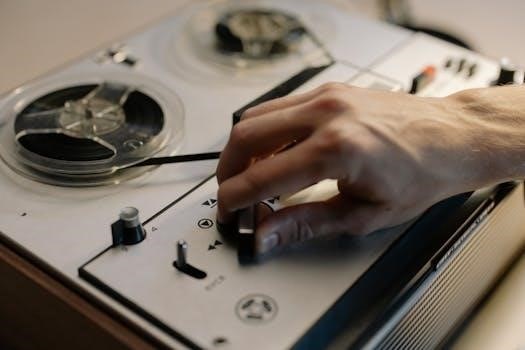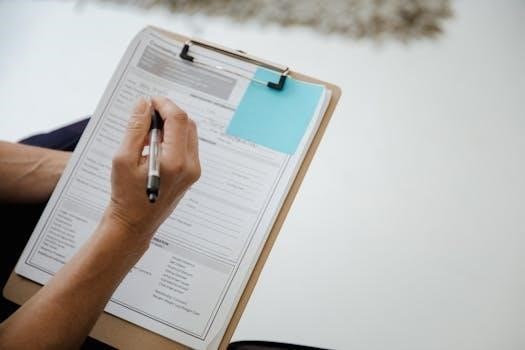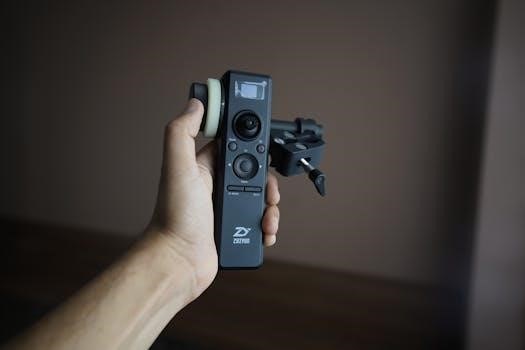The Bravo reflux recorder is a device utilized to monitor gastroesophageal pH levels․ This system employs a capsule-based test‚ designed to measure and monitor reflux‚ providing essential data for diagnosis․ The recorder is recording for 48 hours․
Understanding the Bravo Reflux System
The Bravo Reflux System is a calibration-free‚ capsule-based technology specifically designed to measure and monitor pH levels within the esophagus․ This system is integral in diagnosing and managing gastroesophageal reflux disease (GERD)․ The core of the system involves a small‚ disposable capsule that is temporarily attached to the esophageal lining․ This capsule transmits pH data wirelessly to an external receiver worn by the patient․ The receiver‚ in turn‚ records this data‚ which can be later analyzed by healthcare professionals․ The Bravo system allows for ambulatory monitoring‚ enabling patients to continue their daily routines while the test is being conducted․ This approach provides a more natural and comprehensive view of reflux patterns compared to traditional stationary tests․ The data gathered by the Bravo system is crucial for accurately assessing the frequency and severity of acid reflux‚ aiding in the development of effective treatment plans․ This technology offers a less invasive and more patient-friendly method for reflux monitoring‚ improving diagnostic accuracy and patient comfort․

Bravo Capsule Placement
The Bravo capsule is placed in the esophagus to monitor for reflux․ It is temporarily attached to the esophageal lining․ This procedure is essential for accurate pH measurement․ The capsule transmits data wirelessly․
Purpose of the Bravo pH Capsule
The primary purpose of the Bravo pH capsule is to meticulously monitor the esophagus for instances of acid reflux․ This tiny‚ yet sophisticated device‚ is strategically placed within the esophagus to accurately measure pH levels over an extended period․ This continuous monitoring helps to identify patterns and frequency of reflux episodes‚ which are vital for diagnosing gastroesophageal reflux disease (GERD)․ By continuously assessing pH fluctuations‚ the Bravo capsule provides clinicians with comprehensive data to assess the severity and impact of reflux․ This information is also crucial in determining the most effective treatment strategy․ The capsule’s ability to transmit data wirelessly to a receiver enhances patient convenience and data collection efficiency․ In essence‚ the Bravo pH capsule serves as a crucial tool for understanding and managing reflux-related conditions‚ offering a more precise and detailed view of esophageal acid exposure․

Using the Bravo Recorder
The Bravo recorder is used to record reflux data and patient activity for up to 96 hours․ The recorder has button to record symptoms‚ activities and lying down periods․
Activating the Recorder
The Bravo reflux recorder is designed to automatically begin recording data once the Bravo capsule is placed․ The recorder itself does not require a separate “start” activation by the patient․ It is crucial to understand that the device operates for a predetermined period‚ typically 48 hours‚ after the capsule placement․ The recorder should be kept with the patient for the entire monitoring duration․ Prior to the capsule placement‚ the recorder might be on standby with its backlight off; however‚ pressing any button will turn the backlight on but not initiate recording․ The recording starts immediately after capsule placement‚ so patient action is not needed․ It’s essential to follow any specific instructions provided by the healthcare professional who placed the capsule to ensure proper data collection․
Recording Symptoms and Activities
During the Bravo reflux monitoring‚ it is essential to accurately record any symptoms experienced and daily activities․ Patients should use the provided diary to note the time of symptoms such as chest pain‚ cough‚ regurgitation‚ or heartburn․ When a symptom occurs‚ record it immediately in the patient diary․ The Bravo recorder has buttons to record symptom events directly into the data stream․ It is important to follow instructions to record symptoms correctly․ Use the recorder to mark the time of the symptom in the symptom box․ Also note all activities performed‚ like eating meals‚ exercise‚ or rest periods․ This information helps correlate the recorded pH data with specific events․ Proper and thorough recording of symptoms and activities is crucial for the doctor to interpret the Bravo test results effectively․
Recording Lying Down Periods
Accurately recording lying down periods is a crucial part of using the Bravo reflux recorder․ The Bravo system is designed to detect changes in esophageal pH while you are in various positions‚ so it’s important to record these correctly․ You must record a lying down period whenever you lie down or recline at less than a 45-degree angle․ This could be while resting‚ sleeping‚ or any other activity involving a reclined position․ When you lie down‚ immediately press the appropriate button on the recorder to mark the start of the lying down period․ Similarly‚ when you get up‚ press the button again to mark the end of the period․ These precise notations allow the physician to correlate any reflux events with your posture․ This ensures a comprehensive analysis of your reflux activity․ This accurate recording enhances the accuracy of the test results․

Bravo Recorder Operation
The Bravo recorder is designed to record reflux data and patient activity․ If the recorder is on standby‚ press any button to turn it on․ Then‚ press desired button to record․
Button Functionality
The Bravo reflux recorder features specific buttons that serve distinct purposes during the monitoring process․ When the recorder is in standby mode‚ indicated by the backlight being off‚ any button press will activate the device‚ bringing it out of standby․ Following activation‚ the primary function of the buttons is to record specific events or symptoms as they occur․ These buttons allow the patient to accurately log when they experience symptoms like heartburn‚ regurgitation‚ chest pain‚ or cough․ Additionally‚ the buttons can be utilized to mark when a patient is lying down or reclining at less than a 45-degree angle‚ which is crucial for data interpretation․ Each button press is registered by the device and stored along with the corresponding time stamp‚ enabling a detailed analysis of reflux events in relation to patient activity and symptoms․ Utilizing the buttons correctly is essential for generating comprehensive and reliable reflux data․
Backlight Activation
The Bravo reflux recorder incorporates a backlight feature designed to enhance visibility of the device’s display‚ particularly in low-light conditions․ When the recorder is in its standby state‚ characterized by the backlight being off‚ the device is not actively recording‚ but is ready to be activated․ To initiate recording or access the device’s functions‚ the user must first activate the backlight․ This is accomplished by pressing any of the buttons on the device․ This action will illuminate the display‚ indicating that the recorder is now active and ready to register data․ It is important to note that pressing a button to activate the backlight will not‚ in itself‚ record an event․ It solely prepares the recorder for use‚ allowing the patient to then press the desired button to record a symptom‚ activity‚ or lying down period․ Once the backlight is active‚ the device will remain on for a short period before returning to standby to conserve battery power․

Data Recording and Analysis
The Bravo reflux recorder captures data for up to 96 hours‚ recording reflux and patient activity․ Test results include recorded symptoms․ After recording‚ data is uploaded for analysis to determine the extent of acid reflux․
Duration of Recording
The Bravo reflux recorder is designed to capture comprehensive data regarding your esophageal pH levels over an extended period․ The standard recording duration for the Bravo system is typically 48 hours‚ allowing for a thorough assessment of reflux patterns․ However‚ the device is capable of recording data for up to 96 hours if needed‚ providing flexibility for different diagnostic needs and patient situations․ This extended recording period is crucial for capturing both daytime and nighttime reflux events‚ ensuring a complete picture of acid exposure in the esophagus․ The duration is set automatically after the Bravo capsule is placed․ The recorded data enables your physician to accurately assess the presence‚ frequency‚ and severity of acid reflux‚ aiding in the development of an effective treatment plan․ The continuous recording over this period allows for a more accurate diagnosis of reflux-related issues․
Interpreting Test Results
The Bravo reflux test results provide valuable insights into your esophageal acid exposure․ The data‚ collected over the recording period‚ reveals the frequency and duration of reflux episodes․ Analysis of the test results includes assessing the percentage of time the esophagus is exposed to acid‚ which helps determine the severity of acid reflux․ Elevated acid exposure‚ indicated by a higher percentage of time with low pH‚ may suggest the presence of gastroesophageal reflux disease (GERD)․ The recorded data will also show any correlation between reflux events and symptoms that were logged in the patient diary․ Your physician will interpret the data‚ taking into consideration your specific symptoms and medical history․ It is very important to discuss the meaning of the test results with your healthcare provider․
Data Upload Process
Following the completion of the recording period‚ the data collected by the Bravo reflux recorder needs to be uploaded for analysis․ The data upload process involves connecting the recorder to a designated docking station or computer‚ depending on the specific model․ The recorded information is then transferred to a secure system‚ ensuring patient data confidentiality․ Once the upload is complete‚ the data is available for review by your physician․ The specific steps for data transfer will be outlined by your healthcare provider or the medical staff․ The data upload allows your physician to review the information and assess the results․ It is essential to follow the instructions carefully․ After uploading‚ you may be asked to start a new study again․
Patient Instructions
During the testing period‚ you should take all other prescription medications as usual‚ unless instructed otherwise․ It is crucial to keep the receiver with you at all times for the duration of the test․
Medication Guidelines During Testing
It is generally recommended that patients continue taking all their regular prescription medications as usual during the Bravo reflux testing period‚ unless specifically instructed otherwise by their healthcare provider․ This is to ensure that the test results accurately reflect your typical daily routine and symptoms while on your current medication regimen․ However‚ certain medications‚ particularly those that affect stomach acid production‚ may need to be temporarily adjusted or discontinued for a short period before and during the test to avoid influencing the test results․ Your doctor will provide you with clear and detailed instructions regarding any medication adjustments you need to make․ It is crucial to strictly follow these guidelines to ensure the test accurately captures your reflux patterns․ If you have any questions or concerns about your medications‚ always contact your healthcare provider for clarification before the test․ Always prioritize following your doctor’s specific advice․
Keeping the Receiver with You
It is imperative that you keep the Bravo reflux recorder receiver with you at all times during the testing period․ The receiver is essential for capturing and storing the data transmitted by the Bravo capsule․ Ensure the receiver is always within range of the capsule‚ typically within a few feet of your body․ This continuous proximity ensures uninterrupted data collection‚ which is vital for accurate test results․ Avoid situations where the receiver might be separated from you‚ such as leaving it in a different room or in a bag while you are mobile․ If the receiver is out of range‚ data might be lost‚ leading to an incomplete or inaccurate study․ To ensure the best possible results and data capture‚ always keep the receiver close by․
